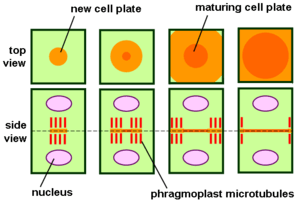Phragmoplast

The phragmoplast is a plant cell specific structure that forms during late cytokinesis. It serves as a scaffold for cell plate assembly and subsequent formation of a new cell wall separating the two daughter cells.
The phragmoplast is a complex assembly of microtubules (MTs), microfilaments (MFs), and endoplasmic reticulum (ER) elements, that assemble in two opposing sets perpendicular to the plane of the future cell plate during anaphase and telophase. It is initially barrel-shaped and forms from the mitotic spindle between the two daughter nuclei while nuclear envelopes reassemble around them. The cell plate initially forms as a disc between the two halves of the phragmoplast structure. While new cell plate material is added to the edges of the growing plate, the phragmoplast microtubules disappear in the center and regenerate at the edges of the growing cell plate. The two structures grow outwards until they reach the outer wall of the dividing cell. If a phragmosome was present in the cell, the phragmoplast and cell plate will grow through the space occupied by the phragmosome. They will reach the parent cell wall exactly at the position formerly occupied by the preprophase band.
The microtubules and actin filaments within the phragmoplast serve to guide vesicles with cell wall material to the growing cell plate. Actin filaments are also possibly involved in guiding the phragmoplast to the site of the former preprophase band location at the parent cell wall. While the cell plate is growing, segments of smooth endoplasmic reticulum are trapped within it, later forming the plasmodesmata connecting the two daughter cells.
The phragmoplast can only be observed in Embryophytes, that is the bryophytes and vascular plants, and a few advanced green algae, specifically Coleochaete in the Division Charophyta. Some algae use another type of microtubule array, a phycoplast, during cytokinesis.[1][2]